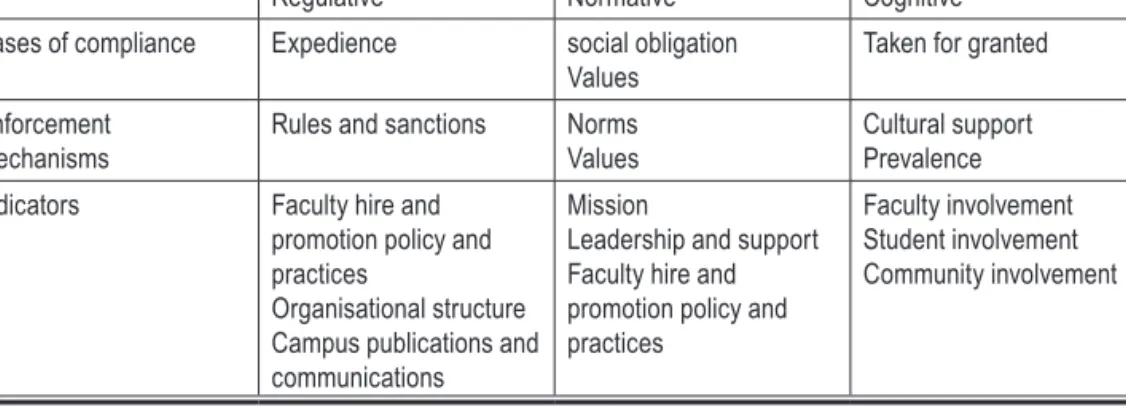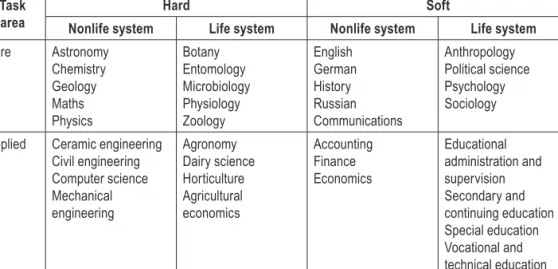Nevertheless, the importance of the third mission is recognized by universities, governments, higher education institutions and so on. The analysis focused on eight aspects of the university that are crucial for the institutionalization of.
Research background
Many African leaders and commentators criticized the colonial university colleges for their elitism, the narrowness of their curriculum and their separation from the wider community and thus sought to end the affiliation of the colleges with the metropolitan universities; to widen access to higher education (HE); reform the curricula of HEIs and transform the HEIs into key instruments for national development (Ajayi et al., 1996, pp. 74–75). These ideas were reiterated during the 1972 Accra workshop on "Creating the African University: Emerging Issues of the 1970s," which encouraged African universities to include the needs of the common person in Africa in their teaching and research activities (Ajayi et al., 1996) ).
Statement of the problem
However, claims made by universities about the importance of TM can be misleading with regard to the universities' commitment to TM because, as Graham (2010) points out, “Carefully managed statements of commitment. This is complicated by a lack of research that systematically examines the status of TM and the nature of TM activities in African universities.
Purpose of the study
Research questions
Significance of the study
TM takes the normative position that universities should share and/or develop knowledge with the external communities without examining what universities are already doing and the challenges for TM. Second, it is expected to provide useful suggestions for further research and deeper institutionalization of TM for HE researchers and managers, respectively.
Definition of selected terms
- Community
- Outreach
- Engagement
- Community engagement
Herein, the term 'outreach' denotes university activities which (a) are deliberately carried out to benefit external communities; (b) utilize knowledge and other academic resources of universities; and (c) support university and unit missions. The term 'engagement', states the Australian Universities Community Engagement Alliance (2008), refers to partnerships that produce mutually beneficial outcomes.
Organisation of the dissertation
Background of the research, research problem, purpose of the research, research questions, significance of the study and key concepts. Organization of TM, institutional commitment to TM, approaches to institutionalization of TM, benefits of TM and challenges for deeper institutionalization of TM.
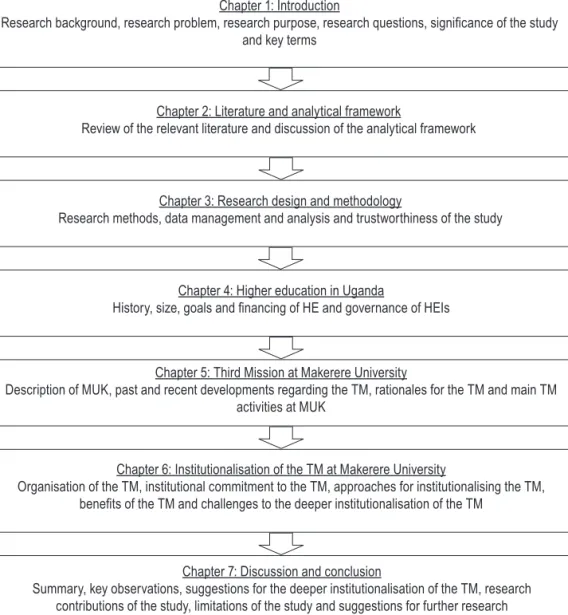
Historical background
Teaching
This chapter reviews the main literature on TM - in particular the institutionalization of TM and institutional involvement in TM - and discusses the analytical framework used to analyze MUK's institutional involvement in TM.
Research
According to Gleeson (2010), “The most important measure of this mission is a steady flow of graduate students who have earned degrees in designated fields of civilized study” (p. 123). According to Gleeson (2010), it is fair to say that, in most countries today, there is a strong consensus on the centrality of the teaching and research missions.
Third Mission
However, there is no single definition of universities' TM (see Table 1 for some of the definitions). What is new, however, is the reformulation of this set of activities as the university's third mission.
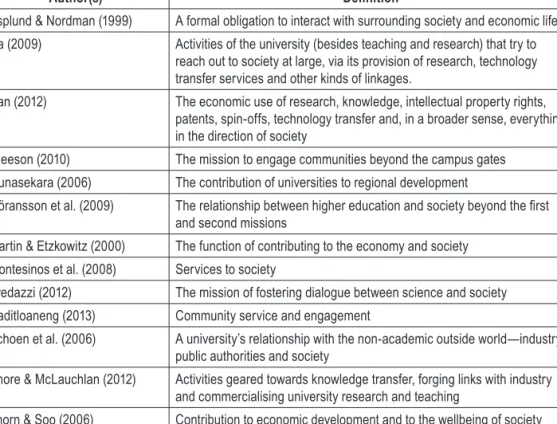
Justifications for the TM
Benefits of the TM
Active involvement of the academic staff in TM activities also benefits teaching by enabling the academic staff to relate what they teach to social issues, to keep course content up to date and to stimulate and enrich their teaching. Active involvement in TM activities also raises important and interesting questions that enliven research and teaching on campus and consequently stimulate the intellectual life of the entire university (Michigan State University, 1993).
Empirical justifications for the TM
Based on this perspective, TM is both (a) a process through which higher education institutions can create knowledge in the context of partnership and application and (b) an indicator of the changing views of knowledge and the nature of knowledge production in higher education. In an influential analysis of the changing nature of knowledge production, Gibbons et al. 1994) argue that we are witnessing a shift from the Mode 1 form of knowledge production to the Mode 2 form of knowledge production.
Conceptualising the TM
In the period of decolonization, they saw the university as part of the efforts to establish the nation. The scholarship of engagement thus reflects efforts to broaden and deepen the public aspect of academic scholarship.

Institutionalisation
- Institutional theory
- Institutions
- Definitions and previous research
- Institutionalisation of the TM
Normative consensus – the extent to which (a) organizational participants are aware that others are performing the required behavior and (b) there is consensus about the appropriateness of the behavior. The second challenge for the institutionalization of TM concerns the reward systems for the academic staff.

Institutional commitment to the TM
Commitment
Leaders who speak and support certain issues openly and honestly are generally treated as committed (Fox et al., 2011). Thus, to get a holistic picture of engagement, this study focuses on and uses the term 'institutional engagement' to embrace all three components of engagement (Fox et al., 2011) because they are part of the university's internal institutions.
Relationship between commitment and institutionalisation
Despite the importance of each of the three components of commitment (express, institutional and budgetary), examining a university's commitment using one of the components cannot provide a complete picture. However, this does not mean that institutional commitment guarantees institutionalization; The existence of policies and support structures cannot guarantee deeper institutionalization of TM, unless there is normative support for TM and broad involvement of staff, students and external communities (Colbeck, 2002).
Analysing institutional commitment to the TM
Matrix of institutional commitment to service
Promotion, hiring and tenure practices that are compatible with the other organizational characteristics are a critical factor in the institutionalization of TM (Furco & Holland, . 2004). Thus, one indicator of a university's institutional commitment to TM is the level of meaningful and purposeful involvement of external communities in a university's activities (Holland, 1997; Ivanov, 2008).

Modified analytical framework
In this case, the aspects of the normative pillar are mission, leadership and support, and faculty tenure and promotion policies and practices. However, these categories are not mutually exclusive; some of the organizational factors—for example, faculty hiring and promotion policies and practices—may fall into more than one category.

Research methodology
This chapter describes and discusses the research methodology, the methods used to generate and analyze data, and the reliability of the research. Hence, the decision to use a qualitative research methodology was influenced by the nature and purpose of the research and the appropriateness of the qualitative research methodology - the belief that it would enable the researcher to (a) conduct a comprehensive study conduct, (b) make adjustments where necessary and (c) present detailed data (Patton, 1990; Punch, 2005).
Research design
Case selection
For this study, which is an instrumental case study focusing on a single case, case selection was based on a single criterion, explicit institutional recognition of the TM as a core university function. Thus, case selection was performed using a purposive sampling technique (Patton, 2002; Ritchie, Lewis, & Elam, 2003) or criteria sampling (Patton, 2002) - that is, "the selection was done in a conscious manner, with a particular purpose or focus [the criterion mentioned above] in mind” (Punch 2005, p. 187).
Appropriateness of the qualitative case study approach
A purely descriptive, phenomenological case study, with no attempt to generalize, can certainly be valuable in this process and has often helped pave the way to scientific innovation. Thus, based on the fact that this study focuses on knowledge, discovery and interpretation - rather than testing and measuring hypotheses - the qualitative case study was considered the most appropriate approach mainly due to its flexibility and reliance on detail.
Data collection methods and sources
Document reviews
However, as some of the documents had not been prepared for research purposes, the information they offered was often incomplete or incomprehensible from a research perspective. Thus, none of the documents was considered a literal recording (Yin, 2009); they were treated as records and confirmed with interview data.
Interviewing
From the fifth college, the researcher interviewed five people—the principal of the college and four members of the academic staff. Before the interviews, the researcher sent interview requests by electronic mail (e-mail) to five college principals (three were accepted and interviewed, one recommended his deputy and one declined the request and his deputy was interviewed instead) and academic staff members whose e-mail addresses were available on the university website.

Data management and analysis
Thematic data analysis
One of the strengths and reasons for using a thematic analysis approach is that, unlike most other qualitative techniques, the approach requires less knowledge of the intricacies of the theoretical underpinnings of qualitative research (Howitt & Cramer, 2011). Although such recognition is important, the theoretical flexibility of the approach was very useful; it allowed the researcher to develop themes consistently and transparently without limitations.
Analysing qualitative data using NVivo 10: A critique
Thus, the decision to use NVivo 10 in data management and analysis was based on the suitability of the software for the research, the belief that it would help the researcher manage the data and code the data effectively and thematically, access get to the nodes and data quickly and ultimately interpret the data effectively (Bazeley, 2007). Essentially, the role of the software was to facilitate the researcher's efforts to easily and thoroughly manage, access, analyze and interpret the data.
Trustworthiness of the study
- Credibility
- Transferability
- Dependability
- Comfirmability
Consequently, this thesis provides detailed information about the research milieu (e.g. the case setting) and the research process (e.g. the selection of the interviewees and the analysis of data (Shenton, 2004) to enable readers to find out whether the described research situation fits their situation and whether the research findings can be transferred to their situations (Merriam, 1998) The researcher also acknowledges the beliefs that informed his choice of the research methods, the case setting and the interviewees (Gibbs, 2007; Shenton, 2004 ) ).
History, size and composition
Aims and goals
Create advanced knowledge and innovation through research and be able to translate or adapt it to local and Ugandan conditions; To equip students with the knowledge, skills and attitudes that will enable them to enter the world of work as useful members of their communities and the nation at large;.
Governance
Performs any other duties relating to the subjects of UOTIA or other HE powers delegated to it by the Minister or any other Act. However, all higher education institutions (public and private) must be established and must operate in accordance with Sections 118 (Article 1)43 and 123 (Article 1)44 of the UOTIA and their staff.
Financing
However, the increase in demand for higher education, combined with an insufficient expansion of the public university sector as well as insufficient budget allocations to public higher education institutions, created ideal conditions for not only the emergence of private higher education institutions, but also the proliferation of private funds for public higher education educational institutions. Although the share of the education budget allocated to higher education continues to increase, the amount of public funds available to public higher education institutions does not sufficiently cover the costs of inputs that the institutions require to produce good results (NCHE, 2010).

Overview of MUK
The University's vision is "To be the leading institution of academic excellence and innovations in Africa" (http://mak.ac.ug/). In terms of governance, the University Chancellor - who is appointed by His Excellency the President of Uganda on the recommendation of the University Council - is the university's titular head.

The Third Mission at MUK
History
Recent trends
To create an environment that would facilitate the involvement of the public and private sector in the promotion of education. To achieve these goals, the plan outlines three strategies—namely, stakeholder involvement in the university's policy agenda, collaborations, and networks.
Rationales for the Third Mission
Need for additional funding
Implementation of alternative funding strategies – i.e. diversification of funding sources, for example introduction of self-sponsorship and tuition fee scheme for self-sponsored students in 1992, commercialization of service units (eg bookstore, bakery). and guest house), the introduction of user fees and. The most likely explanation is therefore that the university views TM as a mechanism through which

Accountability, relevance and excellence
Therefore, while it is obvious that there are calls for MUK to be more responsive, such demands cannot be easily met within the traditional institutional systems and practices; they require changes in university academic and organizational policies, structures and practices. Therefore, the drive towards deeper engagement with external communities and greater involvement in activities that promote socio-economic development is very much part of the proactive measures adopted by the university to (a) respond to external demands (Bisaso, 211) and (b) transform itself into a leading institution of academic excellence and innovations.
Third Mission activities
Knowledge Transfer and Innovation (KTI)
The flow of expertise from the university to the community is the only element of TM in which almost all interviewees (academic staff) said they were involved. In addition, spin-off companies founded by members of academic staff based on their research activities and outputs are an increasingly common phenomenon at the university.
Continuing education
Although most of the knowledge transfer and innovation activities at MUK thus involve the movement of ready-made knowledge and expert people, the university (its staff and students) is equally involved in activities that generate new knowledge and commercialize existing inventions. At some of the colleges (e.g. CHUSS, CEES and CAES) CE programs are organized and offered by special units, such as the FTBIC, the Human Rights and Peace Centre, the Center for Language and Communication Services and the Center for Lifelong Learning.
Social engagement
The involvement of external actors in the decision-making processes of the university is another form of TM in MUK. It occurs through the participation of selected external members in the advisory, management, review boards and other decision-making bodies of the university.
Organisation of the Third Mission
The aim is to improve human resource development, technology exchange between HEIs and communities, knowledge generation and college relevance (http://cedat.mak.ac.ug/.research/presidential-initiative - project.html). The aim of the institute is to improve academic knowledge, inform public policy and contribute to economic and social development.
Institutional commitment to the Third Mission
- Mission
- Hire and promotion policy and practices
- Organisational structure
- Faculty involvement and commitment
- Student involvement
- Community involvement
- Campus publications and communication
- Leadership and support
Moreover, none of the interviewees doubted the importance of partnerships between the university and the external communities. It is clear from these responses that members of the academic staff (the interviewees) have a positive attitude towards the TM.

Approaches for institutionalising the Third Mission
A policy of hiring and promoting academic staff that rewards innovation and service to the community. Inclusion of the TM as requirements for the appointment and promotion of academic staff.

Benefits of the Third Mission
In addition to the improvement of the university's public image (Ajayi et al., 1996;. The above statements are consistent with the university's political expectations regarding the potential benefits of TM.
Challenges to deeper institutionalisation of the TM
- Lack/unsustainability of funding
- Work overload
- Unfairly balanced promotion and reward practices
- Absence of clear guidelines and definitions
In addition to the 40 hours, each academic staff member is expected to commit some time to serving the university and the community (MUK, 2009). Distribution of the teaching load for the academic staff at MUK Allocation of activity time (hours).
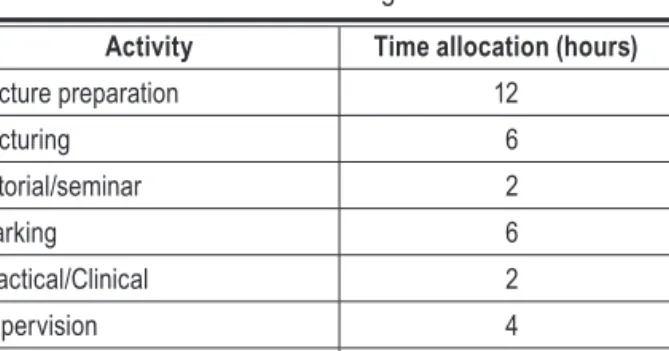
Rationales for the Third Mission at MUK
Additionally, some of the recent TM efforts at MUK are not exceptionally new; the history of TM at MUK (see section 5.2) shows that the connections between the university and the needs of the external community, especially the government, are not a new development. Although the earlier development was part of the colonial and post-colonial development agenda of African universities to meet the development needs of their home countries (Ajayi et al., 1996; Preece et al., 2012a; Sicherman, 2006; UNESCO, 1963), the current developments at MUK are interpreted in relation to the entrepreneurial university (Clark, 1998a, 1998b, 2004) - that is, they are part of the wider initiatives taken by the university to respond to institutional pressures (mainly government expectations); .
Typology of Third Mission activities at MUK
Activities that are officially embedded in the programs of the university, for example field attachment and partly field-based learning;. Activities that bring external communities to the university and/or formally involve the external communities in the university's decision-making processes; and 4.

Approaches for institutionalising the Third Mission
They are the point of contact that makes the many parts of the academic institution more accessible to society. Combined, the administrative, academic, and organizational approaches denote the various policies, programs, practices, and organizational structures at MUK that serve to remove barriers to, promote, and institutionalize TM.
Challenges to further institutionalisation of the TM
R19, for example, noted that although most academic staff members have heavy teaching loads, Equally restrictive for TM are university policies and practices for academic appointments and promotions.
Institutional commitment to the Third Mission
A summary of the analysis of MUK's institutional commitment to TM is presented in Table 22. In addition, TM is expected to; there is a consensus among academic staff on the appropriateness of TM and some members of academic staff are quite familiar with TM and are involved in TM-related activities.

Observations
The summarized analysis of the MUK's institutional commitment to TM presented in Table 22 shows that the university has a number of administrative, academic and organizational structures, policies, programs and practices that promote TM. Fifth, the successful institutionalization of the TM at MUK requires the commitment of not only the university, but also the external stakeholders, especially the government.
Suggestions for deeper institutionalisation of the TM
Administrative
Therefore, even though funding alone cannot address all challenges for the full institutionalization of TM, the university should commit more financial and sustainable resources to TM. Funding should be reserved for activities and projects that match and support the TM agenda and the objectives of the university and the relevant university colleges.
Academic
Since teaching is the main activity carried out at MUK, the further institutionalization of TM requires the university to place TM at the center of its academic activities. Conceptually, therefore, the integration of TM into postgraduate programs has the potential to improve students' (potential academic staff members') understanding of TM and their involvement in TM-related activities.
Organisational
Currently, the PDD works closely with the college communications officers when compiling the annual report of the university. In addition, the interview data shows that the leadership of the university does not provide sufficient support for the TM.
Contributions of the study
Limitations of the study
Selznick (1992), for example, notes that in the process of transforming organizations into institutions, “the formal structure of the organization is a long first step toward institutionalization. Although such measures cannot guarantee the development of a normative consensus on the appropriateness of TM, they can increase the knowledge of university staff and students about TM.
Suggestions for further research
In Global University Network for Innovation (GUNI), Higher education in the world 3: Higher education: New challenges and evolving roles for human and social development (pp. 5–14). Seifer (Eds.), Transformation in higher education: Handbook of engaged scholarship: Contemporary landscapes, future directions, Volume 2: Community-campus partnerships (pp. 5–28).
Interview guide
List of the interviewees
Registered students at Makerere University (2013/2014)
Full-time academic staff at Makerere University (2013/14)
